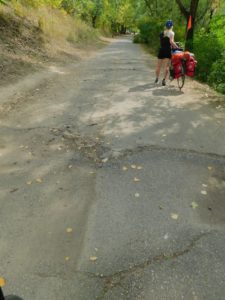Cycling the Danube: From Vienna to Budapest

During our family’s cycling journey around the world, eastern Europe was—hands down—one of the most stressful and scary sections of the trip. Since you’ll be reading about our eastern European adventures in our book Breathtaking, let it suffice for me to say that, as Lorenz and I prepared to leave Vienna and pedal to Budapest on the last leg of our Danube cycling adventure, we were, well, a bit– OK more than a bit– apprehensive.

I’ll admit that as we cycled out of Vienna, I tried to come up with a hundred reasons why we should camp one more night in Austria, instead of staying in Bratislava, Slovakia just past the Austrian border. Unfortunately, the planned Austrian campground was an empty open field, filled with wasps feeding on rotting plums dropped from untended trees. So we pressed on to Slovakia. To my surprise, the border crossing was quite uneventful. In contrast to our scary eastern Europe border crossings during our world cycling tour, this time we simply pedaled past the Slovakian border guards, who ignored us. When we pedaled on into the beautiful, quaint, historic section of Bratislava, it was obvious that my fears of cycling through a foreboding, grey former Communist city were unfounded. As we sat down to dinner at a lovely outdoor restaurant on the bustling cobblestoned streets of the old town, I couldn’t help laughing at my initial anxiety.
I laughed too soon. The next day, as we pedaled across the border into Hungary, it was obvious that Hungary was not Austria—nor even Slovakia. There were no guards at this border, just a crumbling shack overgrown with vines marking the crossing. The bike path immediately changed from a flat, well paved route to a potholed, rocky slalom course. Within fifteen minutes, my rear end was aching from bouncing over tree roots—an experience we endured all the way to Budapest. The cute Austrian towns with fabulous cafes for cyclists were


replaced with silent, empty villages; we pedaled for miles hunting for even a solitary store or cafe or restaurant where we could stop and rest our saddle-sore bottoms. Instead of cycling past delightful Austrian chalets with wooden balconies filled with gardenias, we followed roads lined with sad, square houses with peeling paint, and enormous, abandoned Soviet-style, concrete high-rises looming over the flat, endless Hungarian plain. Just to make sure the misery was complete, although it was late September, the temperatures rose each day well into the upper eighties; and the few scattered trees gave little shade under a cloudless sky. I truly wished we had ended our journey in Vienna.

Then, unexpectedly after two days of bumpy, sunburned misery, we cycled into the delightful old city of Gyor. True, the edges of Gyor were crumbling and tattered. But the center of town was undergoing a major renovation, revealing a thousand year old city with an ancient bishopric complete with a major cathedral, castle and cobblestoned alleyways. For the next few days the pattern continued—one that we had also observed on our bike tour through Vietnam. We’d cycle through the poor, neglected countryside each day, to arrive at another historic town—Komarno, Estergom, Vac–busily rebuilding to welcome tourists and industry.
The highlight, of course, was arriving in Budapest after another day of dodging potholes and cycling under crumbling, grey former Soviet high rises. We stood proudly on the banks of the Danube and took photos with the famed parliament building in the background, 1500 kilometers (or 930 miles) after our start at the Danube spring.
That night, as we gazed down with delight on the twinkling lights of Budapest from the fairytale Fisherman’s Bastion, I wondered: Would I recommend cycling through Hungary to Budapest? Perhaps not. But then again, one of the main reasons I love to tour by bicycle is that you see the real country in between the beautiful tourist destinations advertised in all the brochures.

The real picture is not always pretty castles and cute outdoor restaurants. And the real story of the Danube is that of a river flowing through thousands of years of human history: from prehistoric caves to ruins of Roman fortresses, along charming medieval towns and the majestic baroque cities of the Austrian empire–and, yes, even past crumbling Communist era factory towns–to arrive at the complex and multifaceted ancient modern city of Budapest.
On second thought, I wouldn’t have done it any other way.
To read about other sections of the Danube cycling route go to Cycling the Danube: Passau to Vienna and Cycling from Donauesching to Passau
Want more great cycling adventures, photos and stories or have questions about a trip you want to take? Write to us at info@bike4breath.com. Follow us on Instagram @bike4breath. Or sign up for our blog at https://bike4breath.com/contact-us/. You might also love reading our book, Breathtaking: How one family cycled around the world for clean air and asthma about our family’s cycling adventures around the world–through 24 countries across Europe, Asia, the South Pacific and North America.
One thought on “Cycling the Danube: From Vienna to Budapest”
Comments are closed.


Thanks for this post. It’s interesting that you found Slovakia and Hungary to be so different. What an experience to see it all firsthand and thanks for sharing your findings!